
Food Safety Bulletin for Consumers 2013 (1 st Issue)
Published by the Centre for Food Safety
Feature Article
Green Muscle Disease
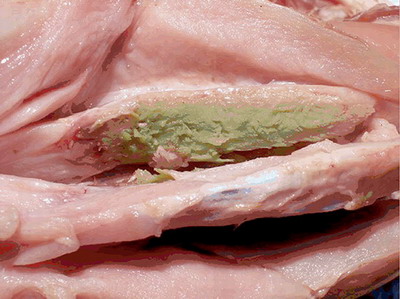
Green Muscle Disease (or Oregon Disease) is a common name given to a degenerative muscle disease known as Deep Pectoral Myopathy (DPM), a condition characterised by necrosis of the breast tender (pectoralis minor) muscles of poultry selected for meat production, and is a problem of increasing economic significance in the poultry industry. Breast fillets and tenders are economically the most important muscles of poultry. Severe red, purple and green discoloration of broiler tenders is a frequent cause of trim and condemnation once discovered during the deboning process in the plant.
DPM develops more frequently in commercially raised broiler chickens as the chickens are kept relatively inactive during the growing period. Consequently, the pectoral muscles are not exercised enough to increase efficiency of the circulatory supply to the muscles. A short period of sudden and excessive wing flap will cause rapid oxygen deficiency, lack of oxygen (ischaemic necrosis) of the muscle fibres and fall in muscle pH. With the loss of cellular structure and breakdown of h a emoglobin and myoglobin to bile salts, a lesion with progressive greening (as shown in the figure) will develop as a result.
Readers' Corner
Use Nutrition Labels to Become Sodium Savvy
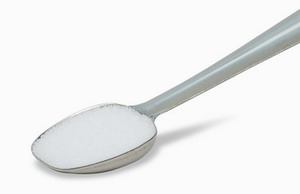
WHO recommends that the daily sodium intake for an adult should be less than 2 000 mg (i.e. approximately equal to 5 g or one level teaspoon of table salt).
High Blood Pressure and Sodium – A Territory-wide Concern
World Health Day is celebrated on 7 April every year to mark the anniversary of the founding of World Health Organisation (WHO) in 1948. Each year a theme is selected for World Health Day that highlights a priority area of public health concern in the world. The theme for 2013 is high blood pressure. According to WHO, one in three adults worldwide has high blood pressure, which is a risk factor for coronary heart disease and stroke. However, the risk of developing high blood pressure can be reduced by lowering the intake of sodium. WHO recommends that the daily sodium intake for an adult should be less than 2 000 mg (i.e. approximately equal to 5 g or one level teaspoon of table salt).
Isn't It That Sodium is Just the Same as Salt? – The Ubiquitous Sodium
When talking about sodium, many people will immediately think of salt or salty foods. In fact, sodium may be described as ubiquitous. Consumers should not think that only foods of a salty taste contain sodium. Table salt and seasonings (e.g. soy sauce and oyster sauce, etc.) of course contain a certain amount of sodium, but sodium is also naturally present in common foods (e.g. milk, fish and vegetables, etc.) and drinking water. On the other hand, sodium may also come from food additives, such as:
- sodium nitrate commonly used as a preservative for curing meats or sausages
- monosodium glutamate (or MSG) commonly used in Chinese cuisine or other dishes
- sodium carbonates used as anticaking agent, acidity regulator or raising agent in biscuits or bread
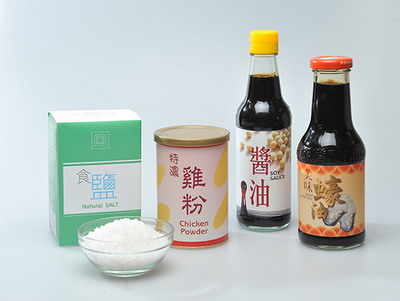
Sodium is naturally present not only in salt and seasonings, but also in foods (such as milk) and food additives in processed foods.
Nutrition Labels – Hidden Sodium Revealed
While sodium is usually hidden in food and it is not possible to determine the sodium content merely by taste, we can clearly know their sodium contents by reading the nutrition labels on prepackaged foods,. With the implementation of the Nutrition Labelling Scheme, all prepackaged foods, unless otherwise exempted, must carry a nutrition label which includes the information on energy content and 7 specified nutrients, namely, protein, carbohydrates, total fat, saturated fat, trans fat, sugars and sodium (i.e. the "1+7").
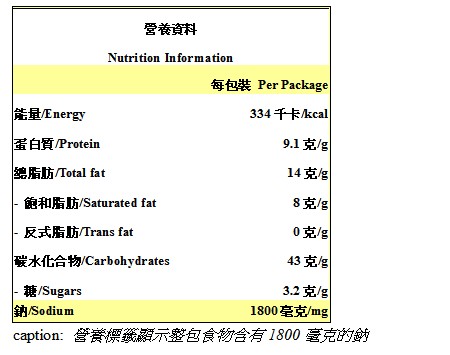
The nutrition label indicates that the whole package of food contains 1 800 mg of sodium.
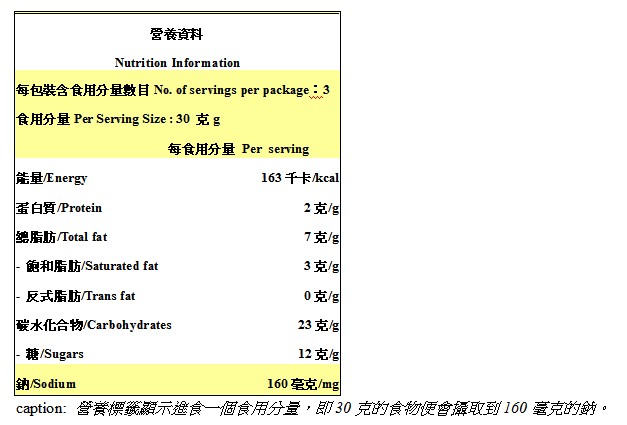
The nutrition label indicates that by consuming one serving (i.e. 30 g of the food), the sodium intake is 160 mg.
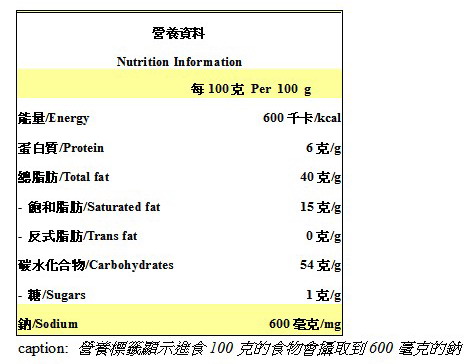
The nutrition label indicates that by consuming 100 g of the food, the sodium intake is 600 mg.

Comparing Nutrition Labels – Know the Difference in Sodium Contents
When purchasing food, we can compare the sodium contents of similar prepackaged food products by referring to their nutrition labels and choose the product with lower sodium content.
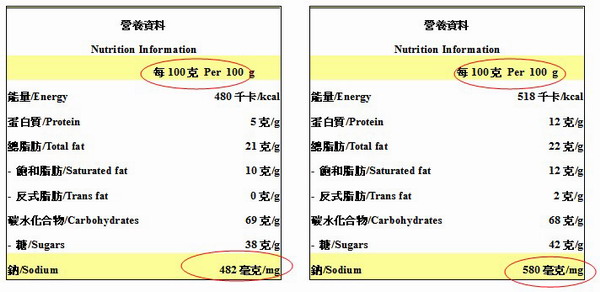
Nutrition label for Brand A biscuits
Nutrition label for Brand B biscuits
The nutrition label indicates that by consuming 100 g of the food, the sodium intake is 600 mg.
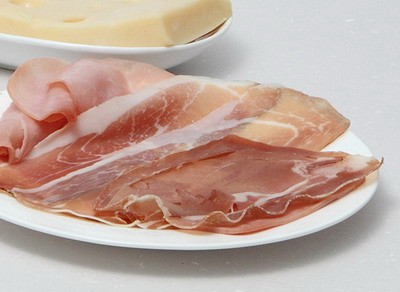
Moreover, nutrition claims such as "low sodium" and "sodium free" can serve as a handy reference for identifying foods which contain less sodium. While there is no universal definition of food with high sodium content for the time being, some countries (such as the United Kingdom) might define foods with high sodium content as those with sodium level exceeding 600 mg per 100 g of food.
| Sodium per 100 g of food | |
|---|---|
| High Sodium | 600 mg |
| Low Sodium | 120 mg |
| Very Low Sodium | 40 mg |
| Sodium Free | 5 mg |
Other than comparing the sodium content on nutrition labels of different foods, consumers can also make reference to the above table for an understanding of low and high sodium levels.
Last but not least, prepackaged foods are only part and parcel of the whole diet. We should not ignore the sodium intake from non-prepackaged foods. Perhaps we may take food with higher sodium content occasionally, but try to avoid other foods of high sodium content (such as pickled food or canned food) and use less salt or seasonings which contain sodium on the same day.
Recommended Tips and Useful Tools
Comparison of the sodium contents on nutrition labels should be made based on the same reference amount of food, e.g. per 100 g versus per 100 g. If the nutrition information on the nutrition labels are expressed as per package or per serving, we should pay attention to whether the total weight / volume or serving size on these labels are the same when comparing the sodium contents among them. Consumers may also make use of an internet tool "Nutrition Label Widget" and a mobile application (app) "Nutrition Calculator" ("NuCal") launched by the Centre for Food Safety (CFS). When the sodium contents of the prepackaged foods that are expressed in different reference amounts are entered, the above tool or app will spontaneously make a comparison among the foods and help us choose the one that is lower in sodium.
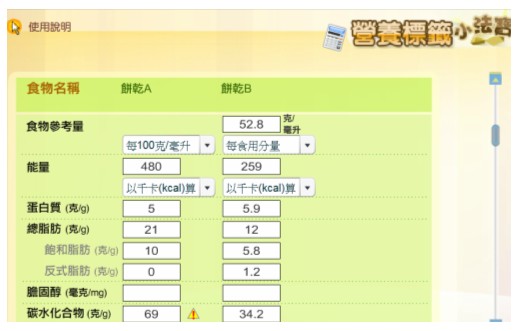
After the values on the nutrition labels are entered, the "Nutrition Label Widget" will help the user spontaneously convert the sodium contents of the foods basing on the same weight, and then choose the food that is lower in sodium.
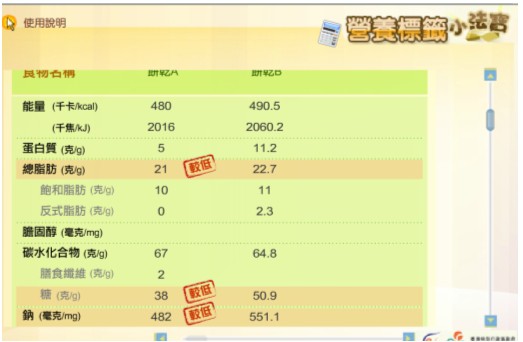
After the values on the nutrition labels are entered, the "NuCal" will help the user in spontaneously convert ing the sodium contents of the foods basing on the same weight, and then list ing the results in ascending order.

↓ Download
"Nutrition Label Widget":
http://www.cfs.gov.hk/english/programme/programme_nifl/nl_widget.html
"NuCal":

For iPhone device
http://itunes.apple.com/hk/app/id469886283?mt=8

For Android device
https://play.google.com/store/apps/details?id=hksarg.fehd.nu
Handy Tips to Get the Temperature Right:
How to Cook Food Thoroughly
Food must be cooked with a core temperature of 75 ℃ or above for at least 30 seconds. For cooked meat and poultry, the juices in the meat should not be red and there should not be any traces of blood when the meat is cut. As for cooked eggs, the yolks should be firm. When cooking or reheating soups and stews, bring them to the boil and keep boiling for at least one minute.
News on New Dishes
Delicious and Healthy – Assorted Seafood with Thousand Layer Bean Curd
Fresh and healthy ingredients complemented by the chef's superb knife skills give a powerful showcase of a colourful, aromatic and delicious dish – Assorted Seafood with Thousand Layer Bean Curd! In this issue, we are honoured to have invited Chef FUNG Kin-wai, head chef of New Star Seafood Restaurant, a signatory of the Food Safety Charter , to demonstrate how to prepare the dish.
| Preparation Steps | Small Tips, Big Wisdom | ||
|---|---|---|---|
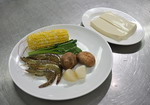 |
Receiving | First, purchase bean curd, shrimps, frozen scallops and other ingredients from approved and reliable sources. | Upon receipt of the ingredients, check with meticulous care to ensure their freshness. Before use, ingredients such as bean curd and shrimps should be kept in a refrigerator at 4 ℃ or below while frozen scallops in a refrigerator at -18 ℃ or below. |
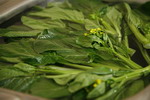 |
Rinsing | Vegetables (including fresh mushrooms) should be soaked and rinsed thoroughly. | Soaking softens the mushrooms. This step not only prepares them for further handling, but also removes contaminants such as sand and mud effectively. |
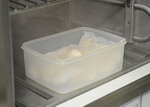 |
Defrosting | Defrost frozen scallops in a refrigerator at 4 ℃ or below. | Defrosting in a refrigerator at 4 ℃ or below is not only safe but also keeps the fresh flavour of scallops. |
 |
Cutting | Cut a block of bean curd into domino-shaped slices. Dice other ingredients: fresh shrimps (50 g), frozen scallops (50 g), fresh mushrooms (2 pieces) and Chinese flowering cabbage (1 piece). Remove corn kernels from the cob. | Cutting bean curd into domino-shaped thin slices and other ingredients into dices shortens the cooking time and makes it easier to cook the bean curd and other ingredients thoroughly. |
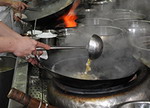 |
Blanching | Blanch diced shrimps, scallops, mushrooms and Chinese flowering cabbage as well as corn kernels in boiling water. Drain them dry when cooked and set aside. | Blanching is a method of cooking which easily ensures that ingredients are cooked thoroughly and takes less time compared to stir-frying the raw ingredients. |
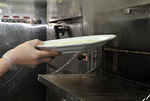 |
Steaming | Arrange the domino-shaped bean curd slices in a circular formation on a plate. Sprinkle salt on them and steam for 2 minutes. | Pre-set the correct time and temperature for steaming. |
 |
Stir-frying | Heat oil in wok. Stir-fry the ingredients until fragrant and centre them in side the circle of bean curd slices. | Brisk stir-frying in wok makes ingredients more delicious and ensures that they are cooked thoroughly. |
 |
Saucing | Add a small amount of water to wok. When water boils, add oyster sauce, salt, sugar, light soy sauce, dark soy sauce and cornflour to thicken the sauce. After bringing the thickened sauce to the boil, pour it onto the bean curd. Ready to serve. | Bring the seasoning sauce to the boil before pouring it onto the bean curd. The food should be consumed immediately. |
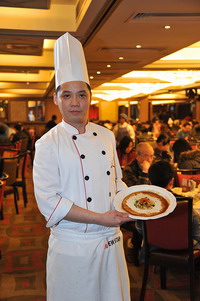
Tips from Chef FUNG:
-
Preparation of bean curd must be done as quickly as possible . Otherwise, the bean curd will soon become dry and lack moisture, making it more difficult to spread out the bean curd slices like domino tiles. Moreover, steam the bean curd slices until yellowish water seeps out, then take them out and set aside. When small holes start to form on the bean curd surfaces, it is already overdone!
-
Quality ingredients are the cornerstone of all tasty dishes. The restaurant will purchase ingredients from reputable and licensed suppliers. Orders are placed according to the estimated consumption of that day to ensure that fresh ingredients are used every day.
-
Upon receipt of the ingredients and before cooking, the staff will thoroughly check whether there are any problems with the ingredients. If the ingredients are found to be damaged on their surfaces or giving out unpleasant smell etc, they will be discarded at once and the suppliers concerned will be informed of the problems.
-
The restaurant has established a supervisory system to ensure cleanliness of food and environment. Various codes of hygiene and operational guidelines have been laid down for staff, who m is also provided with on-the-job training to make sure that they understand and comply with these codes and guidelines.
-
Refrigerators are checked and their temperatures are recorded by staff every day. Moreover, regular maintenance of refrigerators is carried out to ensure that they are in good working order.
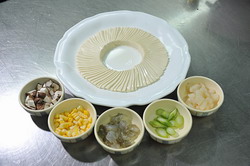
Food Safety Plan Corner
Assorted Seafood with Thousand Layer Bean Curd
Ingredients:
Fresh shrimps, frozen scallops, bean curd, fresh mushrooms, fresh corn on the cob and Chinese flowering cabbage
Seasoning:
Oyster sauce, salt, sugar, light soy sauce, dark soy sauce and cornflour
Method:
-
Defrost frozen scallops in a refrigerator at 4 ℃ or below. Rinse the ingredients with water (soak the vegetables first).
-
Dice shrimps, scallops, mushrooms and Chinese flowering cabbage, and remove corn kernels from the cob. Blanch all these ingredients in boiling water until cooked and set aside.
-
Cut bean curd into domino-shaped slices and steam for 2 minutes.
-
Return the blanched and cooked ingredients to the wok, and stir-fry until fragrant.
-
Cook sauce with seasoning. Pour the thickened sauce onto the bean curd. Ready to serve.
Production Process
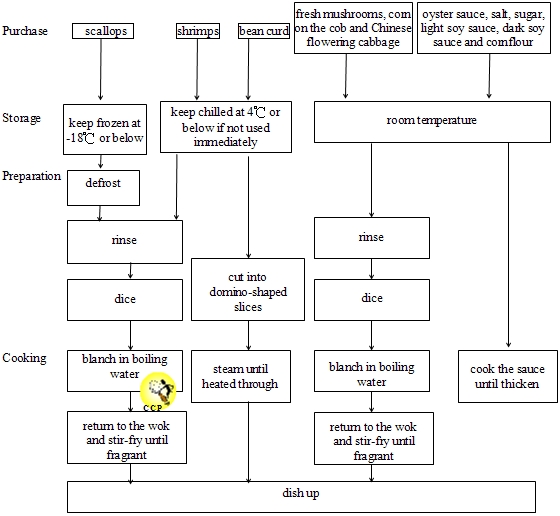
Critical Control Point (CCP)
It is a step or procedure in a food manufacture process at which control can be applied and as a result,
food safety hazard can be prevented or eliminated.
There is one Critical Control Point in the production of Assorted Seafood with Thousand Layer Bean Curd:
- Ingredients should be cooked thoroughly before consumption.
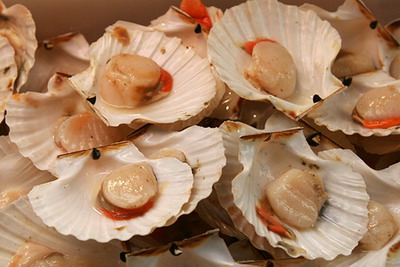
Food Safety Q&A
Q: Will our health be affected if we consume shellfish contaminated with heavy metals?
A:Exposure to high level of mercury, especially organic mercury, can cause adverse effect on the nervous system. Chronic toxicity due to arsenic (inorganic arsenic is more toxic) may lead to nerve damage and diseases of the blood vessels. On the other hand, with chronic toxicity due to cadmium may affect the kidneys .
Generally speaking, shellfish is one of the main dietary sources of cadmium and inorganic arsenic. Consuming food contaminated with heavy metals in trace amount usually will not significantly affect adults' health. Therefore, adults are unlikely to experience acute toxicity caused by heavy metals from normal diet. Of course, health may be affected if we consume shellfish with exceeding levels of heavy metals in a prolonged period of time. Maintaining a balanced diet is important to avoid excessive intake of contaminants. We should not eat too much shellfish.
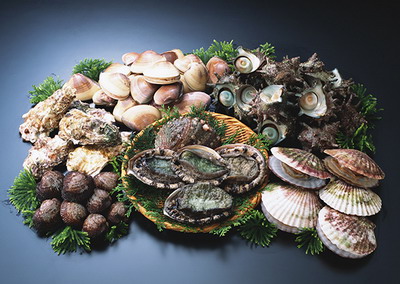
Truth against Fallacy
Q: Since margarine contains trans fats, which can raise the level of the "bad" cholesterol in blood, should we only eat butter?
A:
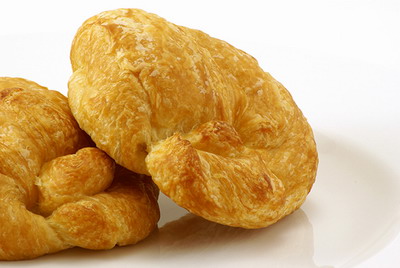
Trans fats mainly come from hydrogenated vegetable oils used as ingredients in the production of food or in frying or baking. However , it should be noted that a low level of trans fats can also be found naturally in the milk and the fats (and their processed products including whole milk and butter) of some animals (sheep and cattle).
Since the consumption of food containing trans fats can raise the level of the "bad" cholesterol (low-density lipoprotein (LDL)) and lower that of the "good" cholesterol (high-density lipoprotein (HDL)) in the human body, thus increasing the risk of coronary heart disease, many people opt for butter in their diet for the sake of health . But is this choice really healthier?
In fact, butter is high in both saturated fats and cholesterol, which are not good for our heart health. On the contrary, most margarine is made from vegetable oils which are cholesterol-free and generally lower in saturated fats.
When choosing butter products, try to look for new formulations of margarine that have come to the market in recent years. They contain little amount of trans fats . Moreover, soft margarine generally has lower trans fats than the harder one.
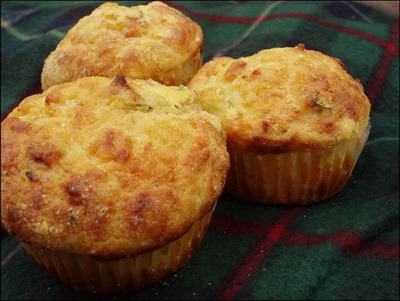
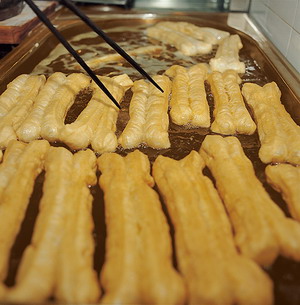
Info Corner
Benzo[a]pyrene in Cooking Oil and Gutter Oil
Benzo[a]pyrene (B[a]P) is a kind of Polycyclic Aromatic Hydrocarbons (PAHs). PAHs are ubiquitous in the environment, being present in air, soil, water, sediment and food. Sources of B[a]P in foodstuffs include contaminated air, water, soil and sediment, and formation and deposition of B[a]P compounds during heating at high temperature s (e.g. roasting, smoking and grilling).
At present, it is not easy to identify cooking oil made from gutter oil or mixed cooking oils of poor quality simply by laboratory test. Nevertheless, test results could ascertain if the cooking oil contains excessive amount of harmful substances. The Codex Alimentarius Commission has not established standard for B[a]P in food. The standards for B[a]P in vegetable oil in the European Union and Mainland China are 2μg/kg and 10μg/kg respectively. The CFS has recently established a provisional action level of 10μg/kg for B[a]P in cooking oil.
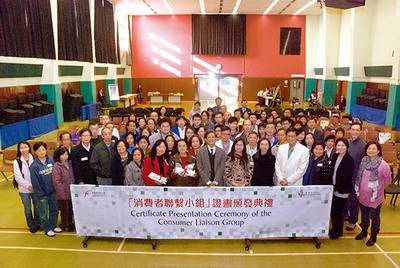
Briefing of Activities
Certificate Presentation Ceremony of the 4 th Term Consumer Liaison Group
The Consumer Liaison Group (CLG) provides a platform for better communication with the public on various food safety issues so as to collect suggestions and comments from them; and to understand the public's knowledge, beliefs and risk perception on various food safety issues in order to tailor risk communication messages to meet their needs.
The Certificate Presentation Ceremony of the 4 th term CLG was successfully held on the afternoon of 8 December 2012 at the Lai Chi Kok Government Offices.
At the ceremony, Dr HO Yuk-yin, Consultant (Community Medicine) (Risk Assessment and Communication) of the CFS gave a welcoming speech and thanked all CLG members for their active participation. Ms Melissa LIU, Scientific Officer of the CFS, then briefed members on the legislative proposals relating to formula products and foods intended for infants and young children in Hong Kong. Members raised questions and expressed views on the proposals. Lastly, Professor MA Ching-yung, Chairman of the Expert Committee on Food Safety, presented the certificates and took photos with members.
Upcoming Activities
Roving Exhibitions on Food Safety in 2013
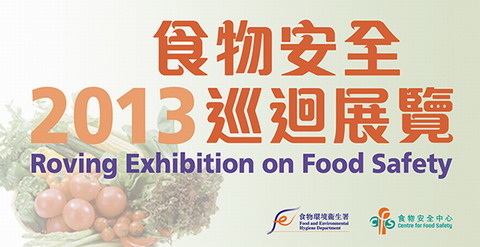
In order to arouse the awareness of the public and the food trade on food safety, the CFS regularly organises thematic exhibitions in public housing estates and major shopping centres. They cover topics such as nutrition labelling, Five Keys to Food Safety, the Food Safety Charter, genetically modified food and food poisoning. Apart from exhibition panels, there are educational videos and interactive games for visitors to enjoy. For details, please visit the CFS website (www.cfs.gov.hk) or call 2381 6096.
Brain Gym
Matching Game
- Benzo[a]pyrene
a) Metabolites from moulds on improperly handled or stored food products (e.g. peanuts, maize, cereals, cottonseeds, tree nuts and some spices) in hot and humid tropical environments. - Aflatoxins
b) Compounds uptake from polluted air by food crops or form ed in food during cooking at high temperature s, such as roasting, smoking and grilling. - Norovirus
c) A potent toxin often associated with the intake of pufferfish. Symptoms of intoxication include numbness sensation in the face and extremities, followed by progressive paralysis and respiratory distress. With high dose exposure, death may occur. - Trans Fats
d) Mainly caused by using hydrogenated vegetable oil as a food ingredient or using it for frying and baking. - Tetrodotoxin
e) Commonly found in shellfish, especially raw oysters, uncooked vegetables, salad and ice cubes. It can cause non-bacterial gastroenteritis in humans.

Enquiry and Subscription
Printed copies of the Food Safety Bulletin can be collected at the Communication Resource Unit located at 8/F, Fa Yuen Street Municipal Services Building, 123A Fa Yuen Street, Mong Kok, Kowloon. For enquiry, please call 2381 6096. The public may also visit the website of the CFS ( http://www.cfs.gov.hk) for the online version.